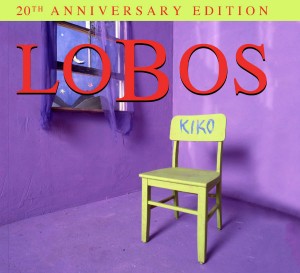 While not the progenitors of magic realism, Latino cultures certainly have been the most prominent users of the form. In novels and plays the spirits walk side-by-side with their living relations and, most often, it is not in the form of a haunting. It is a part of existence.
While not the progenitors of magic realism, Latino cultures certainly have been the most prominent users of the form. In novels and plays the spirits walk side-by-side with their living relations and, most often, it is not in the form of a haunting. It is a part of existence.
That it would be Los Lobos that translated this aspect best into a rock and roll context would initially seem unlikely to me. This is not out of any disrespect to the band — not at all. I was a huge fan of Will The Wolf Survive and especially their follow-up By The Light Of The Moon. And yet that sound they had, while showing the strands of Mexicali heritage, was firmly grounded in a present that seemed to preclude ghosts. It also, to a degree, felt like a throwback to a time in rock that predated the psychedelic era and the British Invasion. There was something intrinsically early-60s, and deeply ”American” about those first recordings. Later records like the EP of traditional Mexican folk music La Pistola y El CorazÁ³n were entrenched in a more obvious ethnic sensibility. The band’s two worlds seemed to live in parallel even though they themselves did not.
While Kiko is a progression of the sounds they fostered, it also was the most effective at integrating them in one place — and it is chock full of ghosts, not lyrically but audibly. One learns from listening carefully to the Anniversary edition of Kiko, co-presented by Shout Factory and Rhino Records, and later with Shout Factory’s DVD of Kiko Live, just how experimental the recording really is. Even with Los Lobos’ instrumentation, hybridized as it is, there was more attention paid to getting those sounds to line up just enough to fit but not quite meld. Even in the prettiest moments there is unease about the music of Kiko, and according to the liner notes and documentary footage from the DVD, that was partly intentional.
 And for those who always felt the band never fully kicked it into gear, Kiko features some of the band’s hardest-rocking moments too, providing the most fully-formed picture of what they were capable of. The majority of the album was written by the main lead singer David Hidalgo, but much of the expansiveness and, to put it plainly dangerousness, is credited to Louie Perez and producer Mitchell Froom who was open to loops and sonic juxtaposition before such were considered common practices. In an interview, Hidalgo spoke of feeling very close to a demo version of a track, and rather than insisting on recutting the entire song in-studio, Froom went with mixing the two extremes one-to-one. By melding the airy rawness of a home six-track recorder with the clarity of studio mics and engineering, that feeling of two realities co-existing was made present in the music.
And for those who always felt the band never fully kicked it into gear, Kiko features some of the band’s hardest-rocking moments too, providing the most fully-formed picture of what they were capable of. The majority of the album was written by the main lead singer David Hidalgo, but much of the expansiveness and, to put it plainly dangerousness, is credited to Louie Perez and producer Mitchell Froom who was open to loops and sonic juxtaposition before such were considered common practices. In an interview, Hidalgo spoke of feeling very close to a demo version of a track, and rather than insisting on recutting the entire song in-studio, Froom went with mixing the two extremes one-to-one. By melding the airy rawness of a home six-track recorder with the clarity of studio mics and engineering, that feeling of two realities co-existing was made present in the music.
It could have been much different. Hundreds of records are made and offered as being unique and bold and all those other descriptors that mask unformed weirdness and lack of discipline, but if Kiko is anything it is definitely not undisciplined. Watching the band play the material live proves it, and also showcases their affection for what they created.
Los Lobos is, in the end, still one of America’s great rock bands. Kiko Live cements it twenty years after its namesake record’s release, and both remain dialed into a world unseen.
Kiko: 20th Anniversary Edition![]() and Kiko Live
and Kiko Live![]() are available at Amazon.com.
are available at Amazon.com.






Comments